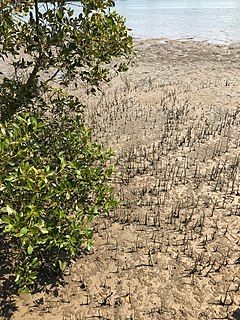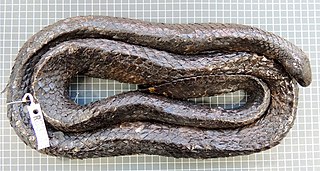
Broome, also known as Rubibi by the Yawuru people, is a coastal, pearling and tourist town in the Kimberley region of Western Australia, 1,681 km (1,045 mi) north of Perth. The urban population was 14,445 in June 2018 growing to over 45,000 per month during the peak tourist season. It is the largest town in the Kimberley region of Western Australia.

The Kimberley is the northernmost of the nine regions of Western Australia. It is bordered on the west by the Indian Ocean, on the north by the Timor Sea, on the south by the Great Sandy and Tanami deserts in the region of the Pilbara, and on the east by the Northern Territory.

Roebuck Bay is a bay on the coast of the Kimberley region of Western Australia. Its entrance is bounded in the north by the town of Broome, and in the south by Bush Point and Sandy Point. It is named after HMS Roebuck, the ship captained by William Dampier when he explored the coast of north-western Australia in 1699. The Broome Bird Observatory lies on the northern coast of the bay.

The Ningaloo Coast is a World Heritage Site located in the north west coastal region of Western Australia. The 705,015-hectare (1,742,130-acre) heritage-listed area is located approximately 1,200 kilometres (750 mi) north of Perth, along the East Indian Ocean. The distinctive Ningaloo Reef that fringes the Ningaloo Coast is 260 kilometres (160 mi) long and is Australia's largest fringing coral reef and the only large reef positioned very close to a landmass. The Muiron Islands and Cape Farquhar are within this coastal zone.

Sea snakes, or coral reef snakes, are a subfamily of venomous elapid snakes, the Hydrophiinae, that inhabit marine environments for most or all of their lives. Most are extensively adapted to a fully aquatic life and are unable to move on land, except for the genus Laticauda, which has limited land movement. They are found in warm coastal waters from the Indian Ocean to the Pacific and are closely related to venomous terrestrial snakes in Australia.

The mangrove red snapper, commonly called mangrove jack within Australia, is a species of snapper. It is also known as creek red bream, the Stuart evader, dog bream, mangrove red snapper, purple sea perch, purple sea-perch, red bream, red perch, red reef bream, river roman, or rock barramundi.

Pearling in Western Australia existed well before European settlement. Coastal dwelling Aboriginal people had collected and traded pearl shell as well as trepang and tortoise with fisherman from Sulawesi for possibly hundreds of years. After settlement, Aboriginal people were used as slave labour in the emerging commercial industry in a practice known as blackbirding. Pearling centred first around Nickol Bay and Exmouth Gulf and then around Broome to become the largest in the world by 1910.

The Anjajavy's Protected Area is located on a peninsula of the town of Antonibe, in the district of Analalava and in the north-west region of Madagascar. It is part of the Sofia region of the independent province of Mahajanga and its position is between 47°13’ at 44°22’ of longitude east and 14°58 at 15°07’ of latitude south..
The wildlife of Japan includes its flora, fauna, mammals, and natural habitats. The islands of Japan stretch a long distance from north to south and cover a wide range of climatic zones. This results in a high diversity of wildlife despite Japan's isolation from the mainland of Asia. In the north of the country, north of Blakiston's Line, there are many subarctic species which have colonized Japan from the north. In the south there are south-east Asian species, typical of tropical regions. Between these areas lies the temperate zone which shares many species with China and Korea. Japan also has many endemic species that are found nowhere else in the world, making it home to many endangered/rare species.

Exmouth Gulf is a gulf in the north-west of Western Australia. It lies between North West Cape and the main coastline of Western Australia. It is considered to be part of the region of the North West Shelf and in the Canning Basin area.

Thalassina is a genus of mud lobsters found in the mangrove swamps of the Indian Ocean and western Pacific Ocean. Its nocturnal burrowing is important for the recycling of nutrients in the mangrove ecosystem, although it is sometimes considered a pest of fish and prawn farms.
The Yawuru, also spelt Jawuru, are an Indigenous Australian people of the Kimberley region of Western Australia.

Australia has approximately 11,500 km2 of mangroves, primarily on the northern and eastern coasts of the continent. Areas where mangroves occur include the intertidal zone of tropical, subtropical and protected temperate coastal rivers, estuaries, bays and marine shorelines. Less than 1% of Australia's total forest area is mangrove forest.

The Marble-toothed snake-eel is an eel in the family Ophichthidae. It was described by Charles Henry Gilbert in 1898. It is a marine, tropical eel which is known from the eastern central and southeastern Pacific Ocean, including Costa Rica, Colombia, Panama and Ecuador. It dwells in shallow waters at a maximum depth of 10 metres (33 ft), and inhabits sand and mud sediments and mangroves. Males can reach a maximum total length of 68 centimetres (27 in).

Solitary Islands Marine Park (SIMP) is a marine park in New South Wales State waters, Australia. It adjoins the Solitary Islands Marine Reserve and was declared under the Marine Parks Act 1997 (NSW) in January 1998. Prior to this it was declared a marine reserve in 1991. The Park was one of the first declared in NSW and stretches along the northern NSW coast, from Muttonbird Island, Coffs Harbour, to Plover Island near Sandon River, 75 kilometres to the north. It includes coastal estuaries and lakes and extends from the mean high water mark, to three nautical miles out to sea, covering an area of around 72 000 hectares. There are five main islands in the Park, North Solitary Island, North West Solitary Island, South West Solitary Island, South Solitary Island and Split Solitary Island, as well as other significant outcrops such as Muttonbird Island and submerged reefs.

Aipysurus apraefrontalis, commonly known as the short-nosed sea snake or Sahul reef snake, is a critically endangered species of venomous sea snake in the family Elapidae, which occurs on reefs off the northern coast of Western Australia. English herpetologist Malcolm Arthur Smith described the species in 1926 from a specimen collected on the Ashmore Reef.
Myron is a genus of snakes in the family Homalopsidae. They are commonly known as 'mangrove snakes'.
Brachyurophis roperi, also known as the northern shovel-nosed snake, is a species of venomous burrowing snake that is endemic to Australia. The specific epithet roperi refers to the type locality of the Roper River Mission in the Northern Territory. It was formerly considered a subspecies of Brachyurophis semifasciatus.
Simoselaps minimus, also known as the Dampierland burrowing snake, is a species of venomous burrowing snake that is endemic to Australia. The specific epithet minimus (“least”) refers to the species’ relatively small size.
Myron richardsonii, also known as Richardson's mangrove snake, is a species of venomous homalopsid snake native to the marine waters of eastern Indonesia and northern Australia. The specific epithet richardsonii honours Sir John Richardson, collector of the original specimen.













